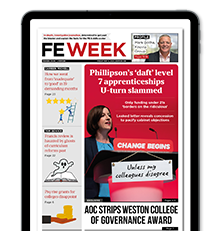Government cuts to education spending over the last decade are “effectively without precedent in post-war history”, according to the Institute for Fiscal Studies.
Contributing heavily to this are a 14 per cent fall in spending per student in colleges and 49 per cent drop in adult education funding.
The economic research institute also states in its annual report on spending that the extra investment announced by the Treasury at the recent spending review for FE will only partially reverse past cuts.
It warns that while the present government has “ambitious goals” to level up poorer areas of the country, emphasising a big role for technical education, changes to education spending have been working in the opposite direction.
Here are the key findings for FE from today’s report…
Overall spending on education falls by £10bn
Between 2010 and 2019, total public spending on education across the UK fell by £10 billion, or 8 per cent, in real terms, according to the IFS.
Researchers say this led to a fall in the share of national income devoted to education spending, down from 5 per cent of national income in 2007 to 4.4 per cent in 2019,
If education spending had remained at 5 per cent of national income, it would have been £16 billion higher in 2019, today’s report reveals.
There was a 3 per cent real terms increase in education spending in 2020, but this “mostly” reflects the temporary extra levels of support during the pandemic.
Extra 16-18 funding will still leave FE 10% short of 2010 levels
The IFS says funding per student aged 16 to 18 in further education and sixth-form colleges fell by 14 per cent in real terms between 2010 and 2019, while funding per student in school sixth forms fell by 28 per cent.
It adds that recent increases in funding, such as the extra £700 million in 2020-21, have been eroded by fast growth in student numbers, which are set for further growth of 10 per cent between 2021 and 2024.
Even with the additional £3.8 billion announced at the 2021 spending review, college spending per pupil in 2024 will still be around 10 per cent below 2010 levels, while school sixth form spending per pupil will be 23 per cent below 2010 levels.
Adult ed and apprenticeships spend still 15% below 2009 levels
In the 2021 spending review, the government allocated an extra £550 million for adult education by 2024–25 (from the previously announced National Skills Fund) and £170 million in increased apprenticeship funding by 2024–25.
As a result of this additional cash, funding for adult education and apprenticeships will rise by 30 per cent in real terms between 2019 and 2024, the IFS said.
However, combined spending on adult education and apprenticeships at this point will still be 15 per cent below 2009 levels.
Spending on adult education on its own fell by 49 per cent between 2009 and 2019 and will still be one-third below 2009 levels even with the additional funding.
Frustration at government’s ‘repeated lack of clarity’ on skills spending
Transparency around the National Skills Fund and other skills policy areas is highlighted as an issue for FE providers in the IFS’ report.
The report states: “The government has promoted the National Skills Fund as a £2.5 billion fund to support adults with training and gaining skills.
“The 2021 spending review allocated £550 million in 2024–25 as part of the National Skills Fund. Yet it is entirely unclear how money will be spread across years and whether the fund has been exhausted.
“Similarly, there remain questions about the design of the forthcoming lifelong loan entitlement. All of this continued uncertainty creates issues for providers of adult education and skills training.”
IFS’ damning verdict on education spending
Luke Sibieta, IFS research fellow and an author of the report, said: “The cuts to education spending over the past decade are effectively without precedent in post-war history.
“Extra funding in the spending review will reverse cuts to school spending per pupil, but will mean 15 years without any overall growth, and college spending per student will still be lower than in 2024.
“Recent funding changes have also worked against schools serving disadvantaged communities. This will make it that much harder to achieve ambitious goals to level up poorer areas of the country and narrow educational inequalities, which were gaping even before the pandemic.
“Fast growth in student numbers in colleges and universities will add to the challenges facing the education sector.”









The total funding envelope is only part of the story, particularly when one considers that the AEB has been underspent nationally in most recent years. When was the last time that AEB qualification funding rates were uprated? How much has the per-aim funding been eroded over the last ten years? The total size of the budget is irrelevant if providers can’t afford to make quality provision because the sums don’t work.